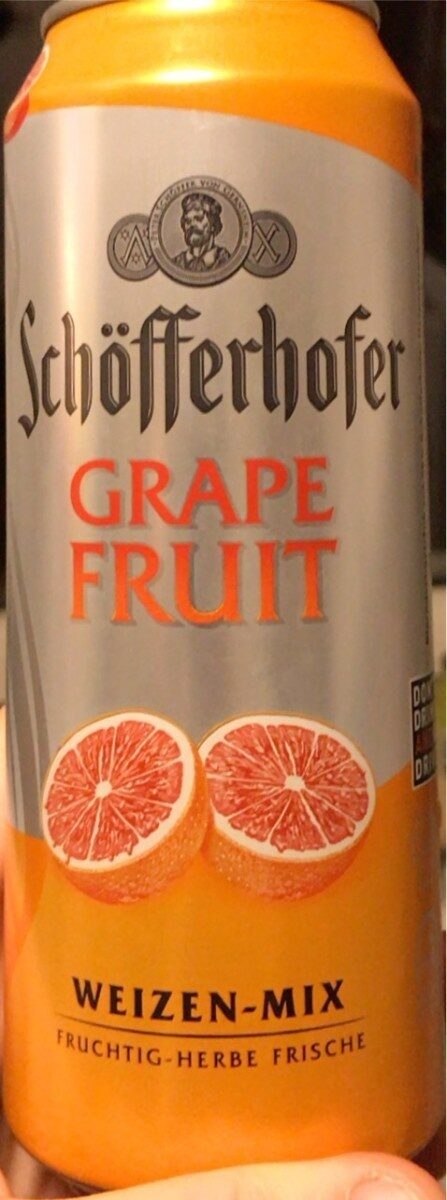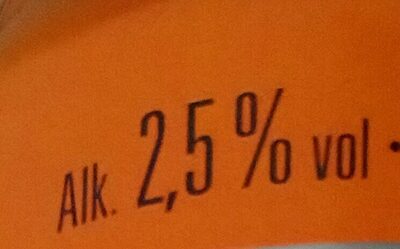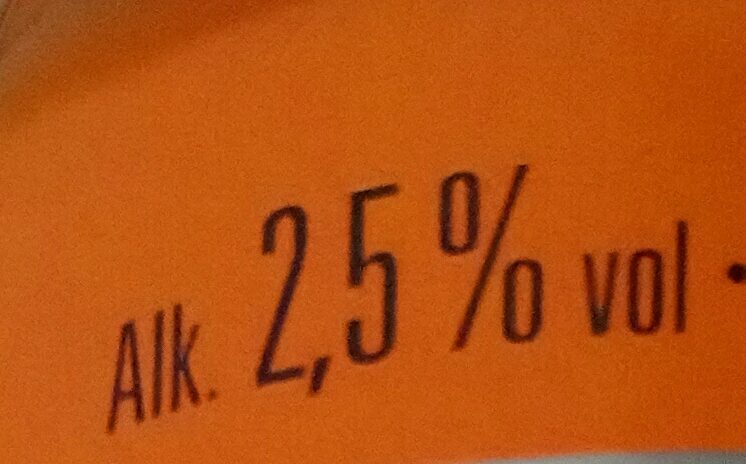Ajuda'ns a fer que la transparència alimentària sigui la norma!
Com a organització sense ànim de lucre, depenem de les vostres donacions per continuar informant els consumidors de tot el món sobre tot allò què mengen.
La revolució alimentària comença amb tu!
Schöfferhofer Hefeweizen-mix Grapefruit Dose 0,5 LTR - 0.5L
Schöfferhofer Hefeweizen-mix Grapefruit Dose 0,5 LTR - 0.5L
Aquesta pàgina del producte no està completa. Podeu ajudar a completar-la editant-la i afegint-hi més dades a partir de les fotos ja disponibles, o fent-ne més amb l'aplicació de androide o iPhone / iPad. Gràcies!
×
Codi de barres: 4053400271729 (EAN / EAN-13)
Quantitat: 0.5L
Empaquetament: en:Metal, en:Recyclable Metals, Alumini
Marques: Schöfferhofer, Schöfferhofer
Categories: Begudes, Begudes alcohòliques, Cervesa, en:Flavored beers
Matching with your preferences
Salut
-
Redueix o deixa de beure alcohol
Menys és millor
Potser no és la resposta que la gent vol escoltar, però no hi ha un nivell segur per beure alcohol. Per descomptat, hi ha consum d'alcohol de menor risc, però l'OMS no posa límits particulars, perquè l'evidència demostra que la situació ideal per a la salut és no beure res. L'alcohol està estretament relacionat amb unes 60 malalties diferents i per a gairebé totes hi ha una estreta relació endre dosi i resposta, de manera que com més es beu, més risc hi ha de patir la malaltia. Menys és millor.
Origen: World Health Organization (WHO) - Q&A – How can I drink alcohol safely?
Ingredients
-
23 ingredients
Alemany: Weizenbier (Wasser, Weizenmalz, Gerstenmalz, Hopfenextrakt, Hefe), Grapefruit-Erfrischungsgetränk (Wasser, Grapefruitsaft (5,5%), Zucker, Zitronensaft, Orangensaft, Kohlensäure, Zitronen - und Orangenextrakt, Säurungsmittel Citronensäure, Antioxidationsmittel Ascorbinsäure, natürliches Grapefruitaroma, Stabilisator Johannisbrotkernmehl, Farbstoff Beta-Carotin);Al·lèrgens: en:Gluten
Processament d'aliments
-
Aliments ultra processats
Elements que indiquen que el producte està al grup 4 - Aliments i begudes ultraprocessats:
- Additiu: E160a - Carotè
- Additiu: E290 - Diòxid de carboni
- Ingredient: Color
- Ingredient: Aromes
Els productes alimentaris es classifiquen en 4 grups segons el seu grau de processament:
- Aliments no processats o mínimament processats
- Ingredients culinaris processats
- Aliments processats
- Aliments ultra processats
La determinació del grup es fa en funció de la categoria del producte i dels ingredients que conté.
Additius
-
E160a - Carotè
Carotene: The term carotene -also carotin, from the Latin carota, "carrot"- is used for many related unsaturated hydrocarbon substances having the formula C40Hx, which are synthesized by plants but in general cannot be made by animals -with the exception of some aphids and spider mites which acquired the synthesizing genes from fungi-. Carotenes are photosynthetic pigments important for photosynthesis. Carotenes contain no oxygen atoms. They absorb ultraviolet, violet, and blue light and scatter orange or red light, and -in low concentrations- yellow light. Carotenes are responsible for the orange colour of the carrot, for which this class of chemicals is named, and for the colours of many other fruits, vegetables and fungi -for example, sweet potatoes, chanterelle and orange cantaloupe melon-. Carotenes are also responsible for the orange -but not all of the yellow- colours in dry foliage. They also -in lower concentrations- impart the yellow coloration to milk-fat and butter. Omnivorous animal species which are relatively poor converters of coloured dietary carotenoids to colourless retinoids have yellowed-coloured body fat, as a result of the carotenoid retention from the vegetable portion of their diet. The typical yellow-coloured fat of humans and chickens is a result of fat storage of carotenes from their diets. Carotenes contribute to photosynthesis by transmitting the light energy they absorb to chlorophyll. They also protect plant tissues by helping to absorb the energy from singlet oxygen, an excited form of the oxygen molecule O2 which is formed during photosynthesis. β-Carotene is composed of two retinyl groups, and is broken down in the mucosa of the human small intestine by β-carotene 15‚15'-monooxygenase to retinal, a form of vitamin A. β-Carotene can be stored in the liver and body fat and converted to retinal as needed, thus making it a form of vitamin A for humans and some other mammals. The carotenes α-carotene and γ-carotene, due to their single retinyl group -β-ionone ring-, also have some vitamin A activity -though less than β-carotene-, as does the xanthophyll carotenoid β-cryptoxanthin. All other carotenoids, including lycopene, have no beta-ring and thus no vitamin A activity -although they may have antioxidant activity and thus biological activity in other ways-. Animal species differ greatly in their ability to convert retinyl -beta-ionone- containing carotenoids to retinals. Carnivores in general are poor converters of dietary ionone-containing carotenoids. Pure carnivores such as ferrets lack β-carotene 15‚15'-monooxygenase and cannot convert any carotenoids to retinals at all -resulting in carotenes not being a form of vitamin A for this species-; while cats can convert a trace of β-carotene to retinol, although the amount is totally insufficient for meeting their daily retinol needs.Origen: Wikipedia (Anglès)
-
E160ai
Beta-Carotene: β-Carotene is an organic, strongly colored red-orange pigment abundant in plants and fruits. It is a member of the carotenes, which are terpenoids -isoprenoids-, synthesized biochemically from eight isoprene units and thus having 40 carbons. Among the carotenes, β-carotene is distinguished by having beta-rings at both ends of the molecule. β-Carotene is biosynthesized from geranylgeranyl pyrophosphate.β-Carotene is the most common form of carotene in plants. When used as a food coloring, it has the E number E160a. The structure was deduced by Karrer et al. in 1930. In nature, β-carotene is a precursor -inactive form- to vitamin A via the action of beta-carotene 15‚15'-monooxygenase.Isolation of β-carotene from fruits abundant in carotenoids is commonly done using column chromatography. It can also be extracted from the beta-carotene rich algae, Dunaliella salina. The separation of β-carotene from the mixture of other carotenoids is based on the polarity of a compound. β-Carotene is a non-polar compound, so it is separated with a non-polar solvent such as hexane. Being highly conjugated, it is deeply colored, and as a hydrocarbon lacking functional groups, it is very lipophilic.Origen: Wikipedia (Anglès)
-
E290 - Diòxid de carboni
Carbon dioxide: Carbon dioxide -chemical formula CO2- is a colorless gas with a density about 60% higher than that of dry air. Carbon dioxide consists of a carbon atom covalently double bonded to two oxygen atoms. It occurs naturally in Earth's atmosphere as a trace gas. The current concentration is about 0.04% -410 ppm- by volume, having risen from pre-industrial levels of 280 ppm. Natural sources include volcanoes, hot springs and geysers, and it is freed from carbonate rocks by dissolution in water and acids. Because carbon dioxide is soluble in water, it occurs naturally in groundwater, rivers and lakes, ice caps, glaciers and seawater. It is present in deposits of petroleum and natural gas. Carbon dioxide is odorless at normally encountered concentrations, however, at high concentrations, it has a sharp and acidic odor.As the source of available carbon in the carbon cycle, atmospheric carbon dioxide is the primary carbon source for life on Earth and its concentration in Earth's pre-industrial atmosphere since late in the Precambrian has been regulated by photosynthetic organisms and geological phenomena. Plants, algae and cyanobacteria use light energy to photosynthesize carbohydrate from carbon dioxide and water, with oxygen produced as a waste product.CO2 is produced by all aerobic organisms when they metabolize carbohydrates and lipids to produce energy by respiration. It is returned to water via the gills of fish and to the air via the lungs of air-breathing land animals, including humans. Carbon dioxide is produced during the processes of decay of organic materials and the fermentation of sugars in bread, beer and wine making. It is produced by combustion of wood and other organic materials and fossil fuels such as coal, peat, petroleum and natural gas. It is an unwanted byproduct in many large scale oxidation processes, for example, in the production of acrylic acid -over 5 million tons/year-.It is a versatile industrial material, used, for example, as an inert gas in welding and fire extinguishers, as a pressurizing gas in air guns and oil recovery, as a chemical feedstock and as a supercritical fluid solvent in decaffeination of coffee and supercritical drying. It is added to drinking water and carbonated beverages including beer and sparkling wine to add effervescence. The frozen solid form of CO2, known as dry ice is used as a refrigerant and as an abrasive in dry-ice blasting. Carbon dioxide is the most significant long-lived greenhouse gas in Earth's atmosphere. Since the Industrial Revolution anthropogenic emissions – primarily from use of fossil fuels and deforestation – have rapidly increased its concentration in the atmosphere, leading to global warming. Carbon dioxide also causes ocean acidification because it dissolves in water to form carbonic acid.Origen: Wikipedia (Anglès)
-
E330 - Acid citric
Citric acid: Citric acid is a weak organic acid that has the chemical formula C6H8O7. It occurs naturally in citrus fruits. In biochemistry, it is an intermediate in the citric acid cycle, which occurs in the metabolism of all aerobic organisms. More than a million tons of citric acid are manufactured every year. It is used widely as an acidifier, as a flavoring and chelating agent.A citrate is a derivative of citric acid; that is, the salts, esters, and the polyatomic anion found in solution. An example of the former, a salt is trisodium citrate; an ester is triethyl citrate. When part of a salt, the formula of the citrate ion is written as C6H5O3−7 or C3H5O-COO-3−3.Origen: Wikipedia (Anglès)
Anàlisi dels ingredients
-
Pot contenir oli de palma
Ingredients que poden contenir oli de palma: Beta-carotè
-
Es desconeix si és vegà
Ingredients no reconeguts: de:weizenbier, de:grapefruit-erfrischungsgetränk, de:natürliches-grapefruitaroma, de:stabilisator-johannisbrotkernmehlAlguns ingredients no s'han pogut reconèixer.
Necessitem la teva ajuda!
Podeu ajudar-nos a reconèixer més ingredients i analitzar millor la llista d'ingredients d'aquest producte i d'altres mitjançant:
- Editeu aquesta pàgina de producte per corregir les faltes d’ortografia de la llista d’ingredients i/o per eliminar els ingredients d’altres idiomes i frases que no estiguin relacionades amb els ingredients.
- Afegiu entrades, sinònims o traduccions noves a les nostres llistes multilingües d’ingredients, mètodes de processament d’ingredients i etiquetes.
Uniu-vos al canal #ingredients del nostre espai de discussió a Slack i/o apreneu sobre l'anàlisi dels ingredients en la nostra wiki, si voleu ajudar. Gràcies!
-
Es desconeix si és vegetarià
Ingredients no reconeguts: de:weizenbier, de:grapefruit-erfrischungsgetränk, de:natürliches-grapefruitaroma, de:stabilisator-johannisbrotkernmehlAlguns ingredients no s'han pogut reconèixer.
Necessitem la teva ajuda!
Podeu ajudar-nos a reconèixer més ingredients i analitzar millor la llista d'ingredients d'aquest producte i d'altres mitjançant:
- Editeu aquesta pàgina de producte per corregir les faltes d’ortografia de la llista d’ingredients i/o per eliminar els ingredients d’altres idiomes i frases que no estiguin relacionades amb els ingredients.
- Afegiu entrades, sinònims o traduccions noves a les nostres llistes multilingües d’ingredients, mètodes de processament d’ingredients i etiquetes.
Uniu-vos al canal #ingredients del nostre espai de discussió a Slack i/o apreneu sobre l'anàlisi dels ingredients en la nostra wiki, si voleu ajudar. Gràcies!
-
Detalls de l'anàlisi dels ingredients
Necessitem la teva ajuda!
Alguns ingredients no s'han pogut reconèixer.
Necessitem la teva ajuda!
Podeu ajudar-nos a reconèixer més ingredients i analitzar millor la llista d'ingredients d'aquest producte i d'altres mitjançant:
- Editeu aquesta pàgina de producte per corregir les faltes d’ortografia de la llista d’ingredients i/o per eliminar els ingredients d’altres idiomes i frases que no estiguin relacionades amb els ingredients.
- Afegiu entrades, sinònims o traduccions noves a les nostres llistes multilingües d’ingredients, mètodes de processament d’ingredients i etiquetes.
Uniu-vos al canal #ingredients del nostre espai de discussió a Slack i/o apreneu sobre l'anàlisi dels ingredients en la nostra wiki, si voleu ajudar. Gràcies!
de: Weizenbier (Wasser, _Weizenmalz_, _Gerstenmalz_, Hopfenextrakt, Hefe), Grapefruit-Erfrischungsgetränk (Wasser, Grapefruitsaft 5.5%, Zucker, Zitronensaft, Orangensaft, Kohlensäure, Zitronen, und Orangenextrakt, Säurungsmittel (Citronensäure), Antioxidationsmittel (Ascorbinsäure), natürliches Grapefruitaroma, Stabilisator Johannisbrotkernmehl, Farbstoff (Beta-Carotin))- Weizenbier -> de:weizenbier - percent_min: 50 - percent_max: 89
- Wasser -> en:water - vegan: yes - vegetarian: yes - ciqual_food_code: 18066 - percent_min: 10 - percent_max: 89
- _Weizenmalz_ -> en:wheat-malt - vegan: yes - vegetarian: yes - ciqual_proxy_food_code: 9410 - percent_min: 0 - percent_max: 44.5
- _Gerstenmalz_ -> en:malted-barley - vegan: yes - vegetarian: yes - percent_min: 0 - percent_max: 29.6666666666667
- Hopfenextrakt -> en:hop-extract - vegan: yes - vegetarian: yes - percent_min: 0 - percent_max: 22.25
- Hefe -> en:yeast - vegan: yes - vegetarian: yes - ciqual_proxy_food_code: 11009 - percent_min: 0 - percent_max: 17.8
- Grapefruit-Erfrischungsgetränk -> de:grapefruit-erfrischungsgetränk - percent_min: 11 - percent_max: 50
- Wasser -> en:water - vegan: yes - vegetarian: yes - ciqual_food_code: 18066 - percent_min: 5.5 - percent_max: 44.5
- Grapefruitsaft -> en:grapefruit-juice - vegan: yes - vegetarian: yes - ciqual_proxy_food_code: 13040 - percent_min: 5.5 - percent: 5.5 - percent_max: 5.5
- Zucker -> en:sugar - vegan: yes - vegetarian: yes - ciqual_proxy_food_code: 31016 - percent_min: 0 - percent_max: 0
- Zitronensaft -> en:lemon-juice - vegan: yes - vegetarian: yes - ciqual_food_code: 2028 - percent_min: 0 - percent_max: 0
- Orangensaft -> en:orange-juice - vegan: yes - vegetarian: yes - ciqual_proxy_food_code: 2070 - percent_min: 0 - percent_max: 0
- Kohlensäure -> en:e290 - vegan: yes - vegetarian: yes - percent_min: 0 - percent_max: 0
- Zitronen -> en:lemon - vegan: yes - vegetarian: yes - ciqual_proxy_food_code: 13009 - percent_min: 0 - percent_max: 0
- und Orangenextrakt -> en:orange-extract - vegan: maybe - vegetarian: maybe - percent_min: 0 - percent_max: 0
- Säurungsmittel -> en:acid - percent_min: 0 - percent_max: 0
- Citronensäure -> en:e330 - vegan: yes - vegetarian: yes - percent_min: 0 - percent_max: 0
- Antioxidationsmittel -> en:antioxidant - percent_min: 0 - percent_max: 0
- Ascorbinsäure -> en:e300 - vegan: yes - vegetarian: yes - percent_min: 0 - percent_max: 0
- natürliches Grapefruitaroma -> de:natürliches-grapefruitaroma - percent_min: 0 - percent_max: 0
- Stabilisator Johannisbrotkernmehl -> de:stabilisator-johannisbrotkernmehl - percent_min: 0 - percent_max: 0
- Farbstoff -> en:colour - percent_min: 0 - percent_max: 0
- Beta-Carotin -> en:e160ai - vegan: maybe - vegetarian: maybe - from_palm_oil: maybe - percent_min: 0 - percent_max: 0
Nutrició
-
Nutri-Score no aplicable
No aplicable a la categoria: Begudes alcohòliques
⚠ ️Nutri-Score no s'aplica a aquesta categoria de producte.Podries afegir la informació necessària per calcular el Nutri-Score?
-
Informació nutricional
Informació nutricional Com es ven
per 100 g/100 mlComparat amb: Cervesa Energia 0 kj
(40 kcal)-100% Greix ? Àcid gras saturat 0 g -100% Hidrats de carboni ? Sucre 0 g -100% Fiber ? Proteïna ? Sal comuna ? Alcohol 2,5 % vol -52% Fruits‚ vegetables‚ nuts and rapeseed‚ walnut and olive oils (estimate from ingredients list analysis) 5,5 %
Entorn
-
Eco-puntuació C - Impacte ambiental moderat
El Eco-Score és una puntuació experimental que resumeix els impactes ambientals dels productes alimentaris.→ L'Eco-Score es va desenvolupar inicialment a França i s'està ampliant per a altres països europeus. La fórmula Eco-Score està subjecta a canvis, ja que es millora periòdicament per fer-la més precisa i més adequada per a cada país.Anàlisi del cicle de vida
-
Impacte mitjà dels productes de la mateixa categoria: C (Score: 57/100)
Categoria: Beer, dark
Categoria: Beer, dark
- Puntuació ambiental PEF ( petjada ambiental de l'aliment ): 0.12 (com més baixa sigui la puntuació, menor serà l'impacte)
- incloent l'impacte sobre el canvi climàtic: 1.12 kg CO₂ eq/kg del producte
Etapa Impacte Agricultura
6.8 %Processament
25.5 %Empaquetament
41.0 %Transport
17.4 %Distribució
7.2 %Consum
2.0 %
Bonificacions i punts negatius
-
Falta informació sobre l'origen dels ingredients
Punts negatius: -5
⚠ ️ L'origen dels ingredients d'aquest producte no està indicat.
Si estan indicats a l'embalatge, podeu modificar la fitxa del producte i afegir-los.
Si sou el fabricant d'aquest producte, podeu enviar-nos la informació amb la nostra plataforma gratuïta per a productors.
-
Embalatge de baix impacte
Punts negatius: -3
Forma Material Reciclatge Impacte Unknown Alumini pesat Mitjà ⚠ ️ La informació sobre l'embalatge d'aquest producte no és prou precisa (formes i materials exactes de tots els components de l'embalatge).⚠ ️ Per a un càlcul més precís de l'Eco-Score, podeu modificar la pàgina del producte i afegir-los.
Si sou el fabricant d'aquest producte, podeu enviar-nos la informació amb la nostra plataforma gratuïta per a productors.
Eco-Score per a aquest producte
-
Impacte per a aquest producte: C (Score: 49/100)
Producte: Schöfferhofer Hefeweizen-mix Grapefruit Dose 0,5 LTR - 0.5L
Puntuació de l'anàlisi del cicle de vida: 57
Suma de bonificacions i punts negatius: -8
Puntuació final: 49/100
-
Petjada de carboni
-
Equivalent a conduir 0.6 km en un cotxe de gasolina
112 g de CO² per cada 100 g de producte
La xifra d'emissions de carboni prové de la base de dades Agribalyse d'ADEME, per a la categoria: Beer, dark (Font: Base de dades ADEME Agribalyse)
Etapa Impacte Agricultura
5.7 %Processament
23.4 %Empaquetament
42.7 %Transport
24.4 %Distribució
3.2 %Consum
0.6 %
Empaquetament
-
Embalatge de baix impacte
-
Peces d'embalatge
(Alumini)
-
Materials d'embalatge
Material % Pes de l'embalatge Pes de l'embalatge per 100 g de producte Metal
-
Transport
-
Orígens dels ingredients
Falta informació sobre l'origen dels ingredients
⚠ ️ L'origen dels ingredients d'aquest producte no està indicat.
Si estan indicats a l'embalatge, podeu modificar la fitxa del producte i afegir-los.
Si sou el fabricant d'aquest producte, podeu enviar-nos la informació amb la nostra plataforma gratuïta per a productors.Add the origins of ingredients for this product Add the origins of ingredients for this product
Report a problem
-
Incomplete or incorrect information?
Category, labels, ingredients, allergens, nutritional information, photos etc.
If the information does not match the information on the packaging, please complete or correct it. Open Food Facts is a collaborative database, and every contribution is useful for all.
Fonts de dades
Producte afegit per anticultist
Última modificació de la pàgina del producte per donatius.
La pàgina del producte, també editada per elcoco, kiliweb, packbot, prepperapp, thaialagata, yuka.sY2b0xO6T85zoF3NwEKvlmhAc_nApxbpBSDnpErU4-2EM67lTPRJx63bbao.








